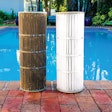
When was the last time you turned on your television or radio and not heard a message of the need to conserve energy? Energy conservation has become a No. 1 topic for the United States, and it was only a matter of time before it would become an issue for swimming pools. Beginning in 2007 in California, there was a major push to develop an Energy Code. The result was Title 20. Soon after that, an effort took hold in Florida, and there was a push to develop an Energy Standard. This resulted in the development of the ANSI/APSP/ICC-15 2011 American National Standard for Residential Swimming Pool and Spa Energy Efficiency.
This new standard set the need to use a variable-speed or multi-speed pump for the filtration system when the pump size was one horsepower or more. There also was a requirement to increase the size of the filters to be used, increase the pipe sizes, and a restriction of the velocity of the water flow. The hard lesson for contractors to learn was this had nothing to do with safety and everything to do with saving energy.
In the next few years, the industry learned that a residential filtration pump was the second largest user of electrical power in a residential home. When the APSP-15 energy standard was introduced, the need to “sell horsepower” was replaced by the need to save money by reducing the energy needs of the circulation pump. Variable-speed pumps became the popular type of pump sold in the market.
In the 2013 revision of the ANSI/APSP/ICC-7 American National Standard for Suction Entrapment Avoidance in Swimming Pools, Wading Pools, Spas, Hot Tubs and Catch Basins, some major changes were made. The main one was the requirement to size the piping to the maximum water flow when the pump was operating at its maximum speed (3450 rpm). This requirement made the use of 3- and 4-inch pipe in residential pools common, which increased the cost to build pools using this new standard. The contractors pushed back, saying that their variablespeed pump did not operate at the maximum speed, so why did they need to use this very large piping? But the regulators responded that the pump “could” operate at the maximum speed, and this speed could result in a much higher flow rate that could be dangerous.
Many states struggled with this issue for the next few years because the ANSI/APSP/ICC-15 Energy Standard made the variable-speed pump a requirement. However, this issue was addressed in the new update of the 2020 ANSI/PHTA/ICC/-7 entrapment standard. This issue was corrected by the change that indicated that the “Design Flow Rate” would determine the pipe size, and that the flow rate at the maximum pump speed would need to be equal to or less than the maximum approved flow rate of the suction outlet cover.
In late 2020, the Pool & Hot Tub Alliance (PHTA) started work on the required revision of the ANSI/APSP/ ICC-15 energy standard. There was an urgent need to accelerate the process to obtain ANSI approval so this new version could be included in the 2024 version of the International Swimming Pool and Spa Code (ISPSC).
Before the development was started, the Department of Energy (DOE) began work on a new federal rulemaking process to address the energy efficiency of swimming pool pumps. This became the Dedicated Purpose Pool Pump Rule (DPPP). In short, this rule required any pump that was one hydraulic horsepower or greater to be a variable-speed pump. Most single-speed and multi-speed pumps were eliminated due to their failure to meet the new efficiency requirements.
In the beginning, only “circulation” pumps were required to meet the energy efficiency standard; this new federal rule included all pumps regardless of how they were used. This meant that there were going to be many more variable-speed pumps used in the market, and that there was an urgent need to revise the ANSI/APSP/ICC-15 Energy Standard to address the increased size of the required piping. PHTA put together an outstanding writing committee. These industry experts met the task and completed their work in record time. The 2021 version of the ANSI/PHTA/ ICC-15 Energy Standard was revised, and the problem was addressed to meet not only the needed energy saving but to increase safety as well. Thus, the newly approved standard became part of the 2024 ISPSC!
The DOE is hard at work again on new energy requirements for not only gas pool heaters, but electric heat pumps as well. PHTA and its members have begun the process to understand what this new regulation would mean to the industry, and to form a consensus to offer changes to what the DOE is trying to do, which is to increase the efficiency of both gas and electric pool/spa heaters. Manufacturers of these products are part of this effort and will help PHTA to form a response to the DOE.
Both the International Code Council (ICC) and PHTA are working together for the betterment of the pool and spa industry. We are blessed with the many volunteers who, together with the ICC and PHTA, are providing the needed expert leadership the industry needs to navigate this issue. If you are interested in getting involved with this major effort, contact PHTA at [email protected] to participate.
To learn more about, read or purchase a copy of the PHTA-15 Standard, please visit the Pool & Hot Tub Alliance website, phta.org. This standard will be referenced in the 2024 International Swimming Pool and Spa Code (ISPSC), a document PHTA publishes in collaboration with the International Code Council (ICC).
Ken Gregory is a Compliance and Safety Manager at Pentair. He is the Chair of the PHTA-15 Standard Writing Committee and a board member of the National Drowning Prevention Alliance.
This article first appeared in the July 2022 issue of AQUA Magazine — the top resource for retailers, builders and service pros in the pool and spa industry. Subscriptions to the print magazine are free to all industry professionals. Click here to subscribe.










































